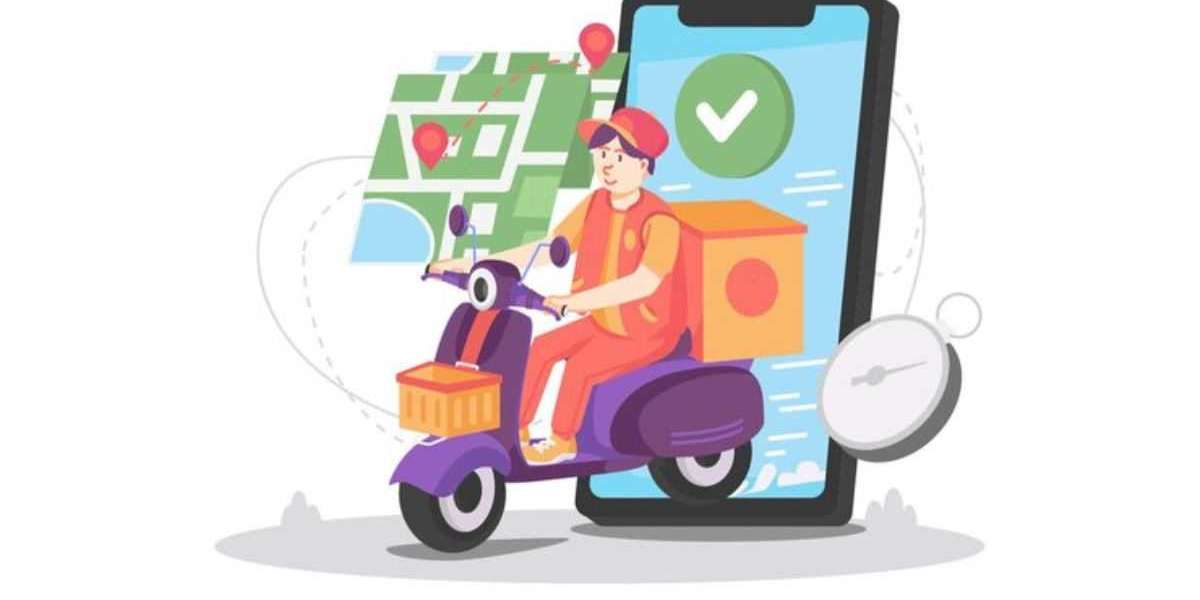Food delivery apps have seen tremendous growth in recent years. As more customers adopt the convenience of online food ordering and delivery services, developing a competitive food delivery app has become crucial for restaurants to reach new markets. However, building a successful food delivery business requires addressing many critical decisions during the app development process.
This article aims to provide thorough guidance on 12 such key decisions that need careful consideration when developing a food delivery application. From choosing the right delivery model and payment options to planning marketing strategies and anticipating operational challenges - each decision impacts the foundation, operation and scalability of the food delivery business.
Delivery Model
One of the most important early decisions is selecting the appropriate delivery model. The three main options are:
Prep-To-Order
In this model, popularized by companies like Domino's, restaurants prepare food only after receiving online orders. This is simplest to implement technically but limits menu sizes and slot availability as food takes time to prepare for each order.
Cloud Kitchens
Exclusive food preparation facilities allow restaurants to focus just on cooking and delivery operations without dining spaces. This model scales better but requires significant real estate investments to set up cloud kitchens.
Traditional Restaurants
Existing restaurants can leverage their food preparation capabilities but delivering quality at peak times may be challenging if the kitchen was not designed for delivery volumes. This model has the advantage of an existing customer base.
Weighing aspects like target audience, menu types, delivery time expectations and investment capabilities will help determine the suitable delivery model. For example, a cloud kitchen model may be well-suited for a food startup targeting busy professionals seeking quick meals.
Payment Options
Offering flexible payment options improves customer satisfaction and checkouts. The payment gateway must support:
Credit/Debit Cards: Most popular payment method for its ease and security. Require PCI compliance.
Cash on Delivery (CoD): Popular in emerging markets. Adds delivery challenges but boosts order volumes.
Digital Wallets: Like Paytm, Google Pay - gaining popularity. Require integrations with payment providers.
Net Banking: Bank account-based payments familiar to customers. May add validation steps.
Operative UPI: Growing in India, allows payments directly from bank apps. Needless to say, security should be top priority across all payment methods.
Offer 2-3 mainstream options based on target region preferences to give customers convenient checkout experiences. One must also factor payment gateway and transaction fees into revenue models.
Delivery Areas
The reachable service area footprint is foundational for customer acquisition and retention. Common expansion approaches are:
Neighborhood optimization: Starting with adjacent areas and radiating outwards utilizing learnings.
Regional rollouts: More methodical approach launching in new cities/areas based on predefined expansion criteria.
Priority zones: Concentrating on high customer density zones first then branching out.
However the app expands, clearly defined geofencing avoids over-committing to unviable areas and disappointing users. Dynamic pricing nudges may also be considered to encourage off-peak orders in new zones. Continuous expansion is key to long term growth. Checkout Zipprr Script: https://zipprr.com/ubereats-clone/
User Experience Design
Immersive and hassle-free user experiences are paramount for modern delivery apps. Key UX elements include:
Simple homepage: Prominently feature deals, top dishes navigation to order flow.
Restaurant browsing: Intuitive filtering, menus optimized for mobile with images.
Ordering: One-click fields to add items, customize checkout seamlessly.
Payments: Intuitive flow integrated with top gateways for fast checkouts.
Tracking: Real-time order status ETA estimation for transparency.
Ratings Reviews: Foster community trust with public, anonymous feedback.
Notifications: Timely delivery alerts by Email/SMS put customers at ease.
Usability testing at each stage ensures glitch-free ordering that keeps users loyal to the platform. Cross-platform support is another important consideration.
Menu Management
Variety and easy customization elevate the dining experience. Facilitate this through:
Partner portals: Allow restaurants to own menu content on a frontend accessible dashboard.
Standardized format: For consistency across listings, prices nutritional info displayed clearly.
Upload tools: Simplify processes like adding dishes with images using template driven uploads.
Promotions: Give flexibility to run time-bound offers or bundleMeals to boost average order values.
Version control: Enables versioning and rollbacks of unpublished changes before live updates.
Dynamic pricing: Consider restaurant-determined surge pricing for high demand periods.
Centralized menu management empowers restaurants while the app offers delightful discovery of tailored choices to diners. Proper monitoring ensures smooth upgrades and compliance.
Delivery Fleet
Fulfillment operations heavily influence speed and reliability parameters. The fleet can be:
Outsourced: Contracting experienced third-party service providers handles scale and liability. Cost model shifts to commercial commissions. Requires careful SLA management.
Employed: Investing in proprietary fleet provides control over standards but increases fixed costs and compliance requirements as employer. Works best at scale.
Key areas of focus include optimized routing, real-time tracking, rider ratings/incentives, insurance, and management systems for order dispatch and payments. Over-reliance on gig workers increases risks, so a hybrid model balancing cost and control is also feasible.
Careful modeling helps determine the most viable and investible fleet strategy matching the business goals and stage. Automation tools streamline operations while maintaining service quality benchmarks.
Marketing Strategy
Building awareness and initial user traction requires well-crafted campaigns across:
Referral programs: Reward customers to share their experience and drive word-of-mouth growth.
Onboarding discounts: Incentivize first orders and repeat usage through temporary deals.
Online advertising: Leverage search, display and social advertising to targeted segments.
PR initiatives: Feature stories in food/tech blogs and local publications.
Restaurant outreach: Drive listings and orders through collateral for restaurant partners.
Strategic partnerships: Collaborate for greater reach, e.g. withcorporations or hyperlocal services.
Content marketing: Generate appeal through how-to guides, restaurant spotlights etc.
Testing different creative concepts and channels helps refine messaging and acquire high lifetime value users cost-effectively in the initial phase.
Operational Challenges
Anticipating common issues in advance sets the foundation for long term trust:
Delayed deliveries: Develop SLA policies, contingency routing for real-time reassignments.
Incorrect orders: Standardize packing/checking procedures backed by order history for mismatches.
Payment errors: Integrate robust payment gateways minimizing declined transactions from the start.
Low order volumes: Monitor restaurant performance and offer analytics/insights for menu changes.
Restaurant attrition: Onboard replacement vendors in priority zones to maintain service consistency.
Seasonal fluctuations: Adapt delivery windows and promotions factoring festive seasonality.
Documented processes, fallback strategies and dedicated support channels establish operational excellence from day one. Periodic reviews improve issue resolution over the long haul.
Technology Stack
Core platform development requires selecting:
Programming languages: Like Java, Kotlin or Swift for mobile apps, PHP/Node.js for backend APIs.
Databases: PostgreSQL, MySQL or MongoDB for seamless scaling of large order volumes.
Mapping SDKs: Google/Apple maps for location services or open-source alternatives.
Payment gateways: Integrations with Braintree, PayPal etc. supporting preferred local payment methods.
Push notification services: For timely updates leveraging platforms like Firebase Cloud Messaging.
Infrastructure: AWS/GCP hosts for redundancy, scalability and auto-provisioning as needed.
CI/CD practices: For development workflows and deployment automation up to production environments.
Careful tech vetting ensures the combination can flexibly support advanced features while meeting performance benchmarks cost-effectively over the long term.
Budget and Revenue Model
Projected operating costs and revenue must balance for viability:
Development: Design, platforms, security certifications etc.
Marketing: Campaigns to achieve target user/merchant acquisition goals.
Operations: Fleet management, customer support etc. can add fixed overheads.
Revenue streams: Balance commisions from restaurants and convenience/delivery fees from customers.
Growth targets: Model for metrics like order volumes, merchant payments etc. to achieve profitability.
Iterative financial planning refines assumptions and softens risks through prudent budgeting as validated learnings emerge with each phase of development.
Legal Compliances
Laws govern various aspects like:
FSSAI/Licensing regulations: On food storage, packaging hygiene protocols for deliveries.
Data privacy: Compliance for handling customer/restaurant financially sensitive data.
Terms of Service: Defining relationships between platform, restaurants and users.
Banking/Payments guidelines: Integrating robustly with payment processors meeting local norms.
Employment laws: If employing delivery staff directly, ensuring compliance on remuneration, welfare etc.
Intellectual property: Managing copyright and brand permissions appropriately.
Geographical regulations: Following local municipal rules around service area permissions.
Thorough legal audits identify requirements while flexible policies factor evolving compliances proactively. Appointing expert advisors provides ongoing counsel navigating regulations holistically. Proper documentation also aids transparency with authorities.
Scaling the Business
While scaling, expansion may involve:
New geographical territories: Careful launch plans tailored for target markets handle logistical challenges.
Cloud kitchen partnerships: Pursue strategic alliances extending delivery capacities cost-effectively.
Dark kitchens/hubs: Clustering commercial kitchen spaces amplifies efficiency for high volumes.
Additional categories: Expand beyond food by facilitating delivery of supermarket goods, medicines etc.
Delivery models: Experiment with niche formats like subscription boxes catering to distinct customer segments.
Delivery modes: Investigate complementing own fleet with collaborative vehicles for hyperlocal coverage.
Technology upgrades: Continuously innovate like adding AR/VR functionalities to stay ahead of the curve.
Prioritizing scalable foundations helps smoothly accommodate growth avenues. Nimble product planning incorporates diverse regional needs and evolving consumer trends.
Conclusion
Building a sustainable on-demand food delivery business requires carefully weighing many interconnected decisions during app development and operations. This article aimed to provide a 360-degree perspective on 12 critical areas shaping the long term viability, experience and success of a food delivery enterprise. With methodical planning addressed step-by-step, upcoming foodtech ventures can establish robust foundations for scaling efficiently as the market matures.








